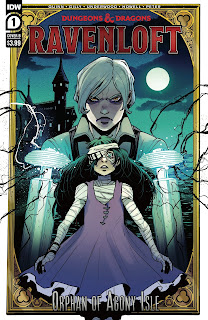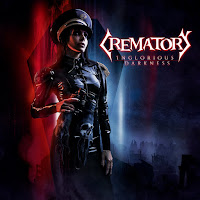I've begun to run the adventures in Journeys Through the Radiant Citadel as part of an open table campaign on my Discord. Without further ado, here's how "The Fiend of Hollow Mine," the third adventure, went for my group on Discord.
Dramatis Personae
Captain Horatio Gurthus, human barbarian
Brother Albany Palmer, human monk
Kill-sin, aasimar warlock
A Dream of Plague, Vile Bounty Hunters
Horatio and Brother Albany were joined by a new companion, Kill-sin, who shared their prophetic dreams. In the third dream granted by the angel, it broke the seal of one of its thirteen scrolls, revealing disturbing images of plague-stricken bodies being thrown into a mass burial pit. Each awoke feeling that if they intervened, the plague's progress could be halted. Unlike the previous dreams that possessed more specificity of location, this one merely pointed them to the vicinity of Strega Hollow.
The party arrived at a town called Millpool that was encircled by a low stone wall. A man in a long leather duster and a tricorne hat sat astride a horse near the entrance to the town; as soon as he spotted their approach, he spurred his horse and disappeared into the town, out of sight. As they came nearer, they heard the crack of a whip and a cry of pain. Once they passed within the stone wall, a number of men in leather coats bearing longbows sprang out of hiding and bid them to leave, immediately. The men were bounty hunters, and they assumed that the party were also manhunters after the same prey--a bandit leader named Paloma.
The bounty hunters were a little too insistent that the adventurers not enter any farther into the town, particularly as they self-described as "meddlers," so the two groups soon came to violence. The bounty hunters were hopelessly outmatched; once three of their number were slain, the rest ran to warn their companions, mount their horses, and flee. Easier said then done with a monk, barbarian, and warlock on your heels. More fell by the wayside, one was knocked unconscious by Brother Albany for later questioning, but some managed to get to their mounts and ride away.
The Corpse Bride and the Bandit Queen
The bounty hunters left behind a wounded townsman, whom they had been torturing for information. Once the bounty hunters were gone, the townspeople began to trickle out of the homes where they had taken shelter. Among those who now emerged was a skeletal woman in a red lace dress. The skin of her hands was desiccated, her nails black and broken. She examined the wound the man had taken from one of the bounty hunters' whips, sent him on his way, and asked the trio if they fancied drinks, on the house, at her tavern.
As she poured them ale at the tavern, the woman pulled back her red lace veil, revealing a corpse-like visage; the skin of her face had pulled back from her teeth and her sockets were devoid of eyes. Introducing herself as Rufina, the woman explained that Paloma was a local hero to the people of the town; she robbed wealthy caravans coming to and from Strega Hollow and distributed the gains to help the poor people of towns like Millpool.
Brother Albany fetched the bounty hunter he had knocked out and tied up for questioning. Bringing him into Rufina's tavern prompted two dwarf patrons to shift the table they had been sitting at and open a trap door that was hidden beneath; from the depths of the tavern emerged Paloma, a middle-aged woman with an eyepatch. Paloma was clearly afflicted by the plague of which they had all dreamed. She explained that her group of brigands had been investigating the cause of the plague. She reported that they had been attacked by an owl-like man whose wings brought a cold wind that carried the disease. One of Paloma's companions, a druid named Lope, believed that killing the creature could end the plague. She believed that the owl-fiend may be nesting in an abandoned mine to the north.
The Catastrophe in the Mine
The group traveled north to the mine, but were surprised to find that it wasn't exactly abandoned. Although the town around the mine had long been derelict, the site was swarming with soldiers in uniforms. A fancy, baroque carriage also looked distinctly out of place amid the squalor. A tiefling with a jade prosthetic horn emerged from the carriage and greeted them. Introducing himself as Itsahn, the man told them that he had bought up the mine and the town around it; he planned to restart the mining operation in the future. He gave them his permission to explore the mine if they wanted to, but cautioned them that it could be dangerous.
The first chamber of the mine featured a elevator platform suspended above the mineshaft. The trio stood atop the elevator; it shuttered with their weight, rust raining down upon them from the chain mechanism above. The elevator began to slowly descend...and then the chains snapped, causing them to plummet into the depths of the mine. A horrible crash at the bottom knocked Kill-sin and Brother Albany unconscious, but the resilient Horatio managed to pull himself and his companions from the rubble.
After everyone was revived, they explored the chamber they now found themselves in. The walls were etched with blasphemous runes; Kill-sin was able to translate them--the words formed the Prophecies of Pazuzu, a demon lord of disease. The Prophecies concerned turning cultists into bird-like avatars of the demon lord in order to spread a supernatural plague. Additionally, they heard an explosion far above then and correctly deduced that Itsahn had detonated something in hopes of burying them alive in the mine.
The chamber also featured a tunnel leading into darkness and an altar carved from stone. Wrapped around the altar was the skeleton of a four-legged beast that no one in the party could identify. Brother Albany mounted the steps of the altar and determined that its blood-stained surface had been used for a recent sacrifice. Of course, as he examined the altar, the skeleton began to detach itself from the altar, readying itself to attack. However, despite being a fearsome beast, it was quickly felled by a combination of a guiding bolt from Kill-sin and a savage attack by Horatio.
After the monster was slain, the group explored the tunnel, which was similarly decorated with Abyssal writings about Pazuzu. However, the walls had also been scratched by claws and they found large feathers scattered throughout. The tunnel culminated in a wall braced with wooden scaffolding. People stricken with the plague were living down in this abandoned mine after being chased from their homes by the folk above. Climbing the scaffolding led to an exit from the cavern; strangely, despite walking not nearly long enough down the tunnel to reach a different town, the group found themselves in the witch-ruled town of Strega Hollow after a festival.
Returning back to the altar chamber, Kill-sin summoned her angelic wings and secured rope at the top of the mine shaft so they could all climb up and explore the mine passages they had passed in their fall. They found a makeshift bedchamber with many drawings of a specific manor house in Strega Hollow, a portrait of Itsahn, and a locket containing a picture of a middle-aged woman with dark hair. Further exploration uncovered a pit of stinking remains--both human and animal--and a laboratory in which three undead abominations writhed on operating tables. According to the scattered notes they found, someone was trying to weaponing the plague by creating zombies infected with the disease. The experimental zombies were destroyed before they left the chamber.
A Distraught Mother, Back Alley Murder, The Cure
Back in Strega Hollow, the group showed the charcoal drawings of the house they had found in the mine to passersby until they were given directions to it. The manor stood on a quiet street in a once-prosperous neighborhood. The dark-haired woman who answered the door was the same as the picture in the locket; she took one look at the group and asked, "Are you here to kill my son?"
Ushering them inside, Rosaria dispelled some of the mysteries of this situation. The owl-creature they were hunting was her son, Seraphio. The previous day, Seraphio had confessed that he had been transforming into a monstrous owl that was causing death and destruction throughout the area. Afterward, he had fled the house. She also revealed that before Seraphio's birth, she had discovered that Orencio (Seraphio's father) was a cultist devoted to the demon lord Pazuzu. She turned Orencio in to the Graymalk family; as diabolic witches, they would not countenance demon worshippers in their domain--Orencio was burned in a pyre in the town square.
Rosaria believed that Orencio, or his fellow cult members who were not apprehended, were responsible for her son's transformation. She also mentioned that Seraphio had been taken under the wing of Itsahn, the wealthy owner of a local ironworks. Since the group wanted revenge on Itsahn for attempting to bury them in the mine, they got the address of his ironworks and set off.
Itsahn was closer at hand than they suspected; they encountered him outside of Rosaria's manor. (He was headed to murder Rosaria, thinking that after Seraphio's confession she knew too much.) Kill-sin cast hold person on Itsahn; he was then dragged into an alley by the group and killed while helpless!
The group continue to the ironworks and were surprised to find it inactive. Using a key they had taken from Itsahn, they ventured inside. Up on the catwalk they saw the hideous owl-demon that Seraphio had become. A combination of entreating him to atone and intimidation caused Seraphio to fight against the transformation; he reverted to his human form. Convinced that the party could help him, he allowed himself to be restrained with rope.
The party debated what to do to effect his cure, and it was decided that they should take him to a bastion of the Church particularly adept at dealing with monstrous transformations. The group found a branch of the Church that was happy to take Seraphio into their care. He was released two weeks later, cured of demonic taint and the plague thus thwarted. However, it was clear that the Church's agents had more or less brainwashed the youth--he now had the zealous demeanor and paranoia of a forced convert.


























